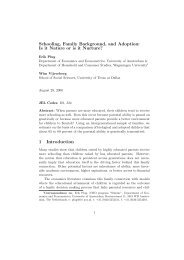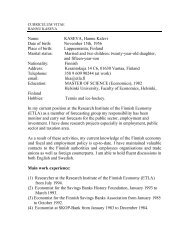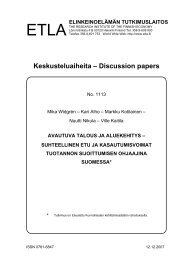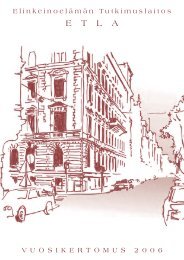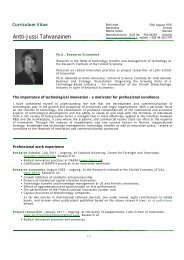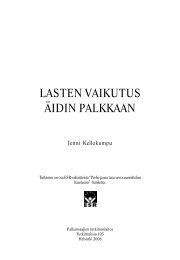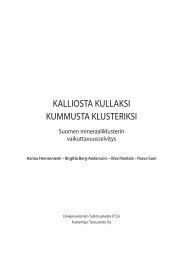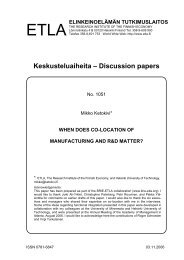Sergey Boltramovich, Grigory Dudarev, and Vladimir Gorelov ... - Etla
Sergey Boltramovich, Grigory Dudarev, and Vladimir Gorelov ... - Etla
Sergey Boltramovich, Grigory Dudarev, and Vladimir Gorelov ... - Etla
You also want an ePaper? Increase the reach of your titles
YUMPU automatically turns print PDFs into web optimized ePapers that Google loves.
operation. Another important impulse the non-ferrous metals production<br />
in Northwest Russia received when after the Second World War the<br />
production of nickel <strong>and</strong> related metals was started based on the deposits<br />
in the annexed area of Pechenga in the Murmansk region.<br />
Development of the cluster was facilitated by presence in the region of<br />
major consumers of metals, i.e. of the large machine building enterprises<br />
located in Leningrad (now St. Petersburg) <strong>and</strong> in other large cities of the<br />
Northwest. It is notable that Severstal, one of the major metallurgy enterprises<br />
in Russia, was built in the proximity of its main consumers, <strong>and</strong><br />
at a rather long distance from deposits located beyond the Polar circle.<br />
The cluster structure was formed in the conditions of closed selfsufficient<br />
socialist central planning economy, <strong>and</strong> is presently in a continuous<br />
process of restructuring <strong>and</strong> adaptation to the new economic<br />
environment, i.e. to the open market economy.<br />
The metal cluster is the leader in production volumes among all industries<br />
of Northwest Russia, <strong>and</strong> accounts for high shares of regional output<br />
of many of its regions. From the industrial production of the Vologda<br />
region it represents the substantial 70% of the total, in Murmansk<br />
region nearly half of the total <strong>and</strong> almost 20% in the Republic of Karelia.<br />
Since during the last decade over a half of the cluster output has been<br />
exported, it is now a significant player in the international markets <strong>and</strong><br />
gets more <strong>and</strong> more dependent on the global market trends.<br />
The analysis of Russian import <strong>and</strong> export of metal products carried<br />
out on the basis of trade statistics of OECD countries allows the conclusion<br />
that the largest export market share belongs to Russian unwrought<br />
metals, intermediary products <strong>and</strong> scrap metal. It is thanks to these categories<br />
of products that Russia now has a strongly positive trade balance.<br />
At the same time, a large amount of higher added value products is imported.<br />
These are the tubes <strong>and</strong> pipes, structures <strong>and</strong> parts of structures<br />
of steel or aluminum, shapes, foil etc. This fact definitely points to a certain<br />
opportunities to develop the import substituting activities. This in its<br />
turn requires substantial investments in upgrading or building the new<br />
facilities. At the same time, it would be necessary to start developing<br />
competitive advantages of the most optimal locations. There is a need<br />
for investment in new facilities or significant upgrading of the existing<br />
ones, <strong>and</strong> for investment in competitive infrastructure, transport <strong>and</strong> logistics,<br />
energy supplies, <strong>and</strong> qualified labor force. One can find only a<br />
few locations in Northwest Russia that meet the criteria for an optimal<br />
location. The role of the government as facilitator <strong>and</strong> provider of the<br />
infrastructure is very important. In our analysis one can find many suggestions<br />
related to industrial policy, which would make the measures<br />
taken by the government more efficient.



